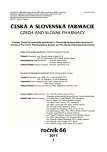Studie složení karboxylových kyselin rhizomů Iris medwedewii a Iris carthaliniae (Iridaceae) pomocí plynové chromatografie ve spojení s a hmotnostní spektrometrií
Authors:
Javanshir I. Isayev; Оlga O. Mykhailenko; Vladumir M. Kovalyov; Gamid M. Gurbanov; Murad Y. Suleymanov
Published in:
Čes. slov. Farm., 2017; 66, 9-14
Category:
Original Articles
Overview
Složení karboxylových kyselin v rhizomech Iris carthaliniae a Iris medwedewii pomocí plynové chromatografie ve spojení s hmotnostní spektrometrií dosud nebylo studováno. Celkový obsah karboxylových kyselin u I. carthaliniae byl 1,34 %, včetně (%) – 0,65 mastných; 0,36 mono-, di- a tri-karboxylových; 0,33 fenolických karboxylových kyselin. Výtěžek karboxylových kyselin u I. medwedewii byl 1,58 %, včetně (%) – 0,73 mastných; 0,38 mono-, di- and tri-karboxylových; 0,47 fenolických karboxylových kyselin. Hlavní postavení v rhizomech I. carthaliniae měly kyselina myristová (25 %), kyselina palmitová (14,41 %), kyselina stearová (10,51 %) a kyselina linolová (6,05 %). Kromě toho kyselina levulová (15,84 %) a kyselina šťavelová (4,42 %) převládaly mezi organickými kyselinami, zatímco kyselina ferulová (2,43 %), kyselina citronová (1,88 %) a kyselina jablečná (3,62 %) převládaly mezi hydroxykyselinami. V rhizomech I. medwedewii byly zjištěny mastné kyseliny – kyselina palmitová (6,51 %), linolová (8,38 %), olejová (3,87 %) a kaprinová (3,21 %). Dále bylo zjištěno, že v rhizomech I. medwedewii mezi organickými kyselinami převládaly kyselina levulová (29,39 %), malonová (1,45 %) a jantarová (1,72 %); kyselina citronová (25,37 %), jablečná (3,30 %) a ferulová (2,42 %) pak převládaly mezi hydroxykyselinami.
Klíčová slova:
Iris carthaliniae • Iris medwedewii • rhizomy • karboxylové kyseliny • plynová chromatografie
Sources
1. Ohlrogge J., Browse J. Lipid biosynthesis. The plant cell 1995; 7, 957–970.
2. Goodwin T., Mercer E. Vvedenie v biokhimiiu rastenii [Introduction to biochemistry of plants] tom 1. Moscow: Mir 1986. (in Russian).
3. Bernardi G. New comprehensive biochemistry. Biochemistry of lipids, lipoproteins and Membranes. Amsterdam: Elsevier 1996; 31, 141–152.
4. Gunstone F. D. Fatty acids and lipid chemistry. London: Blackie Academic and Professional 1996.
5. Gusakova S. V., Sagdulayev Sh. Sh., Khushtakova Z. A. Lipophilic extracts in herbal medicine and bodycare, their preparation and biological properties. Khimiya prirodnykh soedinenii. 1998; 4, 437–447 (in russian).
6. Marri P., Grenner D., Meyes P., Rodyel V. Biochemistry of man: in 2 tom. Мoscow: Mir 1993 (in russian).
7. Plant lipids: biology, utilization and manipulation/eds. Denis J. Murphy. Wiley-Blackwell 2005.
8. Flora of Azerbaijan, in 8 vols. Baku, 1952. T. 2 (in Russian).
9. Isayev D. I., Gurbanov G. M. Summery phytochemical investigations of some plants species belonging to the genus İris from Azerbaijan flora. The modern achivements of Azerbaijan medicine. 2014; 2, 104–109.
10. Rodionenko G. I. An outline of a new and evolutionary botanical classification of Irises. The Iris Year Book. The British Iris Society 1962; 103–119.
11. Goldblatt P., Manning J. C. The Iris family: natural history and classification, Timber Press: Portland 2008.
12. Dykes W. R. The genus Iris. New York: Dover Publications 1974.
13. Austin C. Irises: a gardeners encyclopedia; Portland: Timber Press 2005.
14. Isayev D. I., Kovalev V. N., Gurbanov G. M., Mykhailenko O. A. Quantitative determination of mangiferin in some species of the genus Iris of flora Azerbaijan by HPLC. Plant resources. 2015; 51(3), 444–447.
15. Isayev D. I., Gurbanov G. M. Quantitative determination of flavonoids by spectrophotometry in the raw material of I. carthaliniae and I. medwedewii plants. Azerbaijan pharmaceutical and pharmacotherapy journal. 2014; 1, 27–30.
16. Iwashina T. The structure and distribution of the flavonoids in plants. J. Plant Res. 2000; 113(3), 287–299.
17. Kassak P. Secondary metabolites of the choosen genus Iris spesies. J. Acta universitatis agriculturae et silviculturae mendelianae brunensis 2012; 32(8), 269–280.
18. Kukula-Koch W., Sieniawska E., Widelski J., Urjin O. Major secondary metabolites of Iris spp. Phytochemistry reviews 2013; 12(4), 1–32.
19. Zatylnikova O. A., Osolodchenko T. P., Kovalev V. N. Antimicrobial activity of extracts of Iris pseudacorus L. Scientific J. Annals of Mechnikov’s Institute 2010; 4, 43–47 (in Ukrainian).
20. Williams Ch. A., Harborne J. B., Colasante M. Flavonoid and xanthone patterns in bearded Iris species and the pathway of chemical evolution in the genus. Biochemical Systematics and Ecology 1997; 25(4), 309–325.
21. Kovalyov V. N., Mykchailenko O. A., Krechun A. V. Investigation of lipid composition of rhizomes with roots of Iris hungarica. Rastitelnye resursu. 2015; 3, 406–415 (in Russian).
22. Zatylnikova O. O., Kovalyov S. V., Osolodchenco T. P. The chemical stady of lipophilic fraction from rhizomes of Yellow Iris. Visnuk farmacii 2008; 3(5)5, 9–12 (in Ukrainian).
23. Carrapiso A. I, García C. Development in lipid analysis: some new extraction techniques and in situ transesterification. Lipids 2000; 35(11), 1167–1177.
24. Bicchi C., Brunelli C., Cordero C., Rubiolo P. Direct resistively heated column gas chromatography (Ultrafast module-GC) for high-speed analysis of essential oils of differing complexities. J. Chromatogr. A. 2004; 1024(1–2), 195–207.
25. NIST Mass Spec Data Center SES. 2005a. Mass Spectra, 6th edn. National Institute of Standards and Technology: Gaithersburg MD.
26. NIST Mass Spec Data Center SES. 2005b. Retention.
27. State Pharmacopoeia of Ukraine. 1st ed. Appendix 1. Kharkiv: State Enterprise: Scientific and Expert Pharmacopoeial Centre 2004 (in Ukrainian).
Labels
Pharmacy Clinical pharmacologyArticle was published in
Czech and Slovak Pharmacy

2017 Issue 1
Most read in this issue
- Osudy židovských farmaceutů z českých zemí během holocaustu
- Zdravotnické a nezdravotnické náklady na léčbu a péči Parkinsonovy choroby – srovnání Evropy, USA, Asie a Austrálie
- Samoemulgující systém (SEDDS) pro podání léčiva ibuprofen: hodnocení vzorků v podmínkách in vitro a in vivo
- Cytotoxické, protirakovinné a antimikrobiální účinky extraktů z Artemisia rupestris
